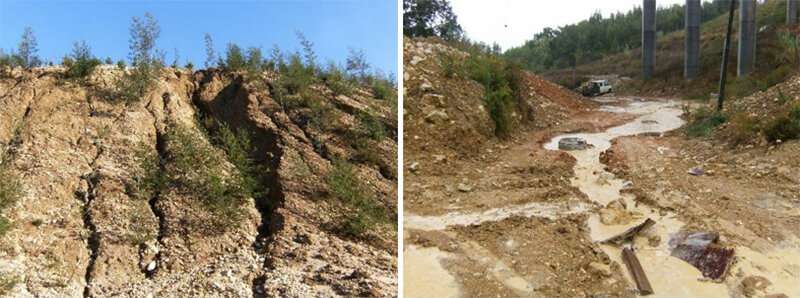Risk of soil degradation and desertification in Europe's Mediterranean may be more serious than realized

Europe's Mediterranean countries produce a significant portion of the world's wines, olives, nuts and tomatoes. But research shows that the region's farms and orchards are the most susceptible in Europe to soil degradation and desertification.
In an analysis of agriculture research and data from the dozen European countries that line the Mediterranean coast, researchers from KTH Royal Institute of Technology in Sweden, Stockholm University and the Navarino Environmental Observatory in Greece found that the Mediterranean region has the overall highest soil erosion rates within Europe, the lowest levels of soil organic matter and severe salinisation problems.
The findings were published in Science of the Total Environment.
Due to human-created pressures and global warming, some soils in Europe's Mediterranean region are reaching what the researchers refer to as "critical limits for their ability to provide ecosystem services," which include farming and absorbing carbon, among others.
Perhaps more troubling, the problem could be even more extensive than we realize, says the study's co-author Zahra Kalantari, an associate professor at KTH.
The degrading soil is a multi-dimensional problem, involving physical, chemical and biological processes, and there are significant gaps in the understanding of the depth and extent of the threat, the authors report. While some studies have investigated economic impacts of declines in crop yields caused by soil erosion, there remains a lack of economic assessments of the impacts of other soil degradation processes in the Mediterranean, Kalantari says.
The researchers point to a Romanian study from 2017, which identified 25 percent of the land in the EU half of the Mediterranean basin as facing high or very high risk of desertification, mainly due to erosion, declining organic matter and biodiversity, contamination, salinisation, sealing (for example, as a result of road or building construction) and compaction from farm machinery and animals.
Many of the physical, chemical and biological degradation processes are well-documented, while others—such as the loss of soil biodiversity—are not. The abundance of organisms and species—such as worms and ants— which provide biodiversity and enrich the soil are under threat from depletion of organic matter, pollution from pesticides and from urban and industrial areas, compaction and erosion, she says.
The threats against soil cannot be tackled without better information about where, when and how these processes are taking place, Kalantari says.
The study recommends compiling of soil assessments "within a harmonized, continuous monitoring system (that) would provide comparable datasets."
"A coordinated network is needed to investigate soil biodiversity and assess its spatial and temporal trends as means for preventing future degradation in the Mediterranean region," Kalantari says.
More information: Carla S.S. Ferreira et al, Soil degradation in the European Mediterranean region: Processes, status and consequences, Science of The Total Environment (2021). DOI: 10.1016/j.scitotenv.2021.150106
Journal information: Science of the Total Environment
Provided by KTH Royal Institute of Technology


















